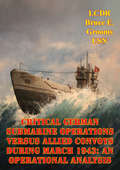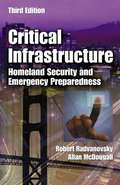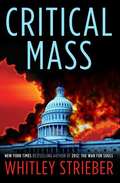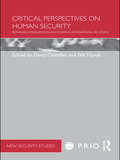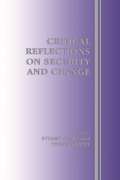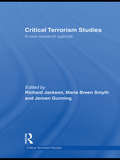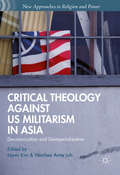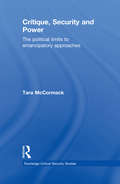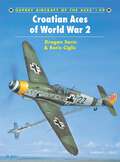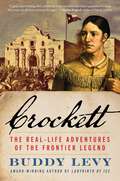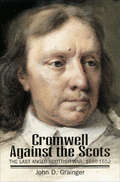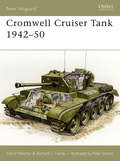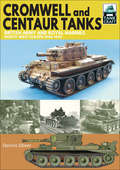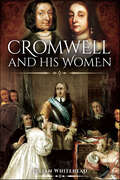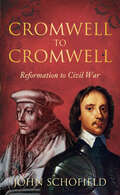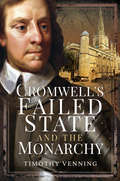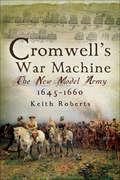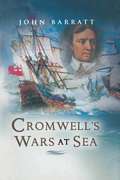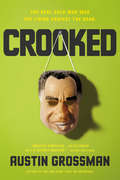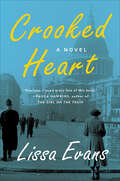- Table View
- List View
Critical German Submarine Operations Versus Allied Convoys During March 1943: An Operational Analysis
by LCDR Bruce E. GroomsGerman submarine operations against allied convoys, during March 1943 is critically analyzed from an operational perspective. The theater commander's operational scheme is dissected for the purpose of identifying lessons which can be applied to the planning and execution of today's theater operations. A brief historical account of the early phases of the war and the events and decisions which preceded the critical convoy battles will be followed by an analysis of the operational scheme employed by Admiral Dönitz. German victory during the spring offensive clearly demonstrated numerous operational successes, a reasonably well conceived operational plan, and proof positive of the potential for a larger scale victory. Yet history recorded Germany's ultimate defeat in the Battle of the Atlantic. This analysis identified three significant flaws which led to the German demise; first, strategic guidance and operational means were inadequately reconciled which prevented the proper execution of the operational plan; second, operational intelligence and reconnaissance were inadequately exploited; third, Germany failed to coordinate and execute joint operations between service arms, specifically the lack of air assets in support of vital U-boat operations. Clearly one must conclude a reasonable operational plan has marginal chance for success when strategic guidance and joint coordination are incompatible with theater objective accomplishment.
Critical Infrastructure: Homeland Security And Emergency Preparedness
by Allan McDougall Robert RadvanovskySince the initial inception of this book, there have been significant strides to safeguard the operations of our world’s infrastructures. In recent years, there has also been a shift to more fluid postures associated with resilience and the establishment of redundant infrastructure. In keeping with the fast-changing nature of this field, Critical Infrastructure: Homeland Security and Emergency Preparedness, Third Edition has been revised and updated to reflect this shift in focus and to incorporate the latest developments.
Critical Mass
by Whitley StrieberA searing new novel from bestselling author Whitley Strieber, exploring the unthinkable but very real possibility - could terrorists get nuclear weapons?
Critical Perspectives on Human Security: Rethinking Emancipation and Power in International Relations (PRIO New Security Studies)
by David ChandlerThis new book presents critical approaches towards Human Security, which has become one of the key areas for policy and academic debate within Security Studies and IR. The Human Security paradigm has had considerable significance for academics, policy-makers and practitioners. Under the rubric of Human Security, security policy practices seem to have transformed their goals and approaches, re-prioritising economic and social welfare issues that were marginal to the state-based geo-political rivalries of the Cold War era. Human Security has reflected and reinforced the reconceptualisation of international security, both broadening and deepening it, and, in so doing, it has helped extend and shape the space within which security concerns inform international policy practices. However, in its wider use, Human Security has become an amorphous and unclear political concept, seen by some as progressive and radical and by others as tainted by association with the imposition of neo-liberal practices and values on non-Western spaces or as legitimizing attacks on Iraq and Afghanistan. This book is concerned with critical perspectives towards Human Security, highlighting some of the tensions which can emerge between critical perspectives which discursively radicalise Human Security within frameworks of emancipatory possibility and those which attempt to deconstruct Human Security within the framework of an externally imposed attempt to regulate and order the globe on behalf of hegemonic power. The chapters gathered in this edited collection represent a range of critical approaches which bring together alternative understandings of human security. This book will be of great interest to students of human security studies and critical security studies, war and conflict studies and international relations.
Critical Perspectives on the Responsibility to Protect: Interrogating Theory and Practice (Routledge Studies in Intervention and Statebuilding)
by Philip CunliffeThis edited volume critically examines the widely supported doctrine of the 'Responsibility to Protect', and investigates the claim that it embodies progressive values in international politics. Since the United Nations World Summit of 2005, a remarkable consensus has emerged in support of the doctrine of the ‘responsibility to protect’ (R2P) – the idea that states and the international community bear a joint duty to protect peoples around the world from mass atrocities. While there has been plenty of discussion over how this doctrine can best be implemented, there has been no systematic criticism of the principles underlying R2P. This volume is the first critically to interrogate both the theoretical principles and the policy consequences of this doctrine. The authors in this collection argue that the doctrine of R2P does not in fact embody progressive values, and they explore the possibility that the R2P may undermine political accountability within states and international peace between them. This volume not only advances a novel set of arguments, but will also spur debate by offering views that are seldom heard in discussions of R2P. The aim of the volume is to bring a range of criticisms to bear from a variety of disciplinary perspectives, including international law, political science, IR theory and security studies. This book will be of much interest to students of the Responsibility to Protect, humanitarian intervention, human security, critical security studies and IR in general.
Critical Reflections on Security and Change
by Stuart Croft Terriff TerryThe contributors reflect critically on security studies since the 1980s. They conclude that analysts and policy-makers have not been able to respond well to the changes that have occurred and that they must revise their approach if they are to meet the challenges of the future.
Critical Terrorism Studies since 11 September 2001: What Has Been Learned?
by David Miller Jessie Blackbourn Helen Dexter Rani DhandaAcademic studies of ‘terrorism’ grew exponentially in number after the September 11 attacks. The problem was that much of this work of ‘orthodox’ terrorism studies was biased, often shoddily researched and was too closely identified with the power centres of Western states. Its denizens were often former and sometimes current officials or officers in the military, intelligence services or the security industry or were funded by them.In response the project of Critical Terrorism Studies was intended to give a more rounded account of political violence in the world. It focuses on neglected issues like state terrorism, Western counterinsurgency, propaganda and misinformation.More than a decade since the founding of the critical project, this book asks what has been learned. It showcases leading examples of critical terrorism studies and presents an agenda for the expansion of an evidence-based approach to political violence and terrorism. With chapters by leading authorities such as Joseba Zulaika, Michael Stohl, Mary Hickman and Richard Jackson, the book evaluates how far the critical project has come and where it is going next.This book was published as a special issue of Critical Studies on Terrorism.
Critical Terrorism Studies: A New Research Agenda (Routledge Critical Terrorism Studies)
by Richard Jackson Jeroen Gunning Marie Breen SmythIn response to the growth of a critical perspective on contemporary issues of terrorism, this edited volume brings together a number of leading scholars to debate the new subfield of 'critical terrorism studies'. In the years since the 9/11 attacks, terrorism studies has undergone a major transformation from minor subfield of security studies into a large stand-alone field, and is probably one of the fastest expanding areas of research in the Western academic world. However, much of the literature is beset by a number of problems, limiting its potential for producing rigorous empirical findings and genuine theoretical advancement. In response to these weaknesses in the broader field, a small but increasing number of scholars have begun to articulate a critical perspective on contemporary issues of terrorism. This volume brings together a number of leading scholars to debate the need for and the shape of this exciting new subfield.The first part of the volume examines some of the main shortcomings and limitations of orthodox terrorism studies, while the second examines exactly what a 'critical' terrorism studies would look like. Contributors from a variety of methodological and disciplinary perspectives give this volume diversity, and it will lay the foundations for, and provoke debate about, the future research agenda of this new field. This book will be of much interest to students of critical security studies, terrorism studies and IR theory in general. Richard Jackson is Reader in the Department of International Politics, Aberystwyth University, where he is also Senior Researcher at the Centre for the Study of Radicalisation and Contemporary Political Violence (CSRV). He is the founding editor of the journal, Critical Studies on Terrorism. Marie Breen Smyth is Director of the Centre for the Study of Radicalisation and Contemporary Political Violence (CSRV) at Aberystwyth University. She is a Reader in International Politics and co-editor of the journal, Critical Studies on Terrorism. Jeroen Gunning is Lecturer in International Politics at Aberystwyth University, Deputy Director of the Centre for the Study of Radicalisation and Contemporary Political Violence and co-editor of the journal, Critical Studies on Terrorism.
Critical Theology against US Militarism in Asia: Decolonization and Deimperialization (New Approaches to Religion and Power)
by Nami Kim Wonhee Anne JohDrawing on cultural studies scholar Kuan-Hsing Chen's threefold notion of decolonization, deimperialization, and de-cold-war, this book provides analyses of the interrelated issues concerning the relationship between Christianity and the United States' imperialist militarism in the Asia Pacific. Contributors explore the effects of US imperialist militarism on the formation of Asian and Asian American collective subjectivity and inter/intra subjectivity. The book investigates the ways in which Christianity (broadly defined), in its own complexity, has been complicit in maintaining and reinforcing US imperialist military agendas in both national and international contexts. Conversely, the volume also discusses the various sites and instances where Christianity has managed to serve as a force of resistance against US imperialist militarism.
Critique, Security and Power: The Political Limits to Emancipatory Approaches (Routledge Critical Security Studies)
by Tara MccormackThis book aims to engage with contemporary security discourses from a critical perspective. It argues that rather than being a radical, analytical outlook, much critical security theory fails to fulfil its promise to pose a challenge to contemporary power relations. In general, 'critical security' theories and dialogues are understood to be progressive theoretical frameworks that offer a trenchant evaluation and analysis of contemporary international and national security policy. Tara McCormack investigates the limitations of contemporary critical and emancipatory theorising and its relationship with contemporary power structures. Beginning with a theoretical critique and moving into a case study of the critical approaches to the break up of the former Yugoslavia, this book assesses the policies adopted by the international community at the time to show that much contemporary critical security theory and discourse in fact mirrors shifts in post-Cold War international and national security policy. Far from challenging international power inequalities and offering an emancipatory framework, contemporary critical security theory inadvertently ends up serving as a theoretical justification for an unequal international order. This book will be of much interest to students of critical security studies, international relations and security studies. Tara McCormack is Lecturer in International Politics at the University of Leicester and has a PhD in International Relations from the University of Westminster.
Croatian Aces of World War 2
by John Weal Boris CiglicInitially flying Italian-supplied Fiat G.50s, the Croat forces suffered heavy losses during 1942 whilst flying alongside JG 52 in the southern sector of the Russian front. Despite this, a significant number of kills fell to future aces such as Cvitan Galic and Mato Dubovak during this time, and when the units re-equipped with Bf 109G-10s in 1943, battle-seasoned Croat pilots started to rack up impressive scores. This book reveals how, by 1944, Croat air groups were defending Yugoslavia from British and American air raids, and in the final months of the war a handful of surviving pilots fought on until final defeat in May 1945.
Crockett: The Real-Life Adventures of the Frontier Legend
by Buddy Levy&“A great myth-busting story, written in a taut narrative style that is guaranteed to keep the reader up all hours turning the pages.&” —Martin Dugard, coauthor of the #1 New York Times bestseller Killing Lincoln (with Bill O&’Reilly)Crack open the most in-depth, exciting portrait of Davy Crockett ever written, from acclaimed bestselling adventure-history author Buddy Levy. Inside is more than just the tale of the coonskin-cap-wearing frontiersman who heroically sacrificed himself at the Battle of the Alamo, but of the real man behind the King of the Wild Frontier myth. From a humble childhood and meager education, the legendary adventurer David Crockett led a distinguished life, winning three elections as a congressman and earning a presidential nomination. Buddy Levy reveals the fascinating truth of Crockett, beyond the newspaper spins and folkloric celebrity status, as a figure that both embraced and clashed with the identity of the American Old West. He was charismatic, down-to-earth, pioneering, independent to a fault, and his adventures have been warped beyond recognition by Hollywood hype. But in this beautifully written narrative, Davy Crockett emerges as never before: a rugged individual, a true American original, and an enduring symbol of the Western frontier.
Cromwell Against the Scots: Last Anglo-Scottish War, 1650-52
by John D. GraingerAfter an introduction establishing Cromwell's war against the Scots from July 1650 to May 1652, this book discusses Charles' landing and Fairfax's resignation as commander-in-chief of the English Republican Army, both events occurred on the same day. It then addresses the causes of the war, Charles II's landing in Northern Scotland from the Continent. The story continues chronologically, from Cromwell's invasion of Scotland, through the Battle of Dunbar, and the slow establishment of the king's power over the Scottish government. The end came with the fall of the last of the Scottish castles, Dunnottar, to English conquest. The Scots enjoyed a distinct military recovery after the Dunbar defeat, but their aims and those of the king were always at cross purposes: the king was intent on the invasion of England, the Scots on resistance to English conquest. Finally, Cromwell's manoeuvres in the summer of 1651, and the English victory at Inverkeithing, allowed the king to invade England. This ended in another Scots defeat at Worcester. The removal of the Scots Army to England meanwhile allowed the English under Monck to complete their conquest of Scotland. Throughout, the political dimension, particularly in Scotland, is kept in view. At the end, the author comments on the relevance of these events to the present Scottish situation.
Cromwell Cruiser Tank 1942-50
by Peter Sarson David FletcherFor most of World War II, British tank development remained faithful to the design philosophy inaugurated during World War I. Experiences in North Africa highlighted flaws in this basic design, however, and the General Staff identified the need for a new heavy cruiser that could combine speed and manoeuvrability with increased armour and armament. The Cromwell Cruiser tank was designed as a result and soon proved itself one of the fastest and most successful tanks deployed by the Allies during World War II. This book details the design and development of the Cromwell and its many variants, from its introduction at D-Day, through its many successes in the final year of World War II and beyond.
Cromwell and Centaur Tanks: British Army and Royal Marines, North-west Europe, 1944–1945 (Tank Craft Ser. #16)
by Dennis Oliver&“An excellent resource for one just starting out trying to model one of these beasts . . . great background information.&” —AMPS Designed with the hard lessons of the North African campaign in mind, including the adoption of a dual-purpose gun capable of firing high-explosive and anti-tank rounds, the Cromwell was one of the most successful of the British cruiser tanks produced during the Second World War. The lack of heavy armor was made up for by the tank&’s high speed, provided by a Rolls-Royce Meteor engine. The Centaur was externally almost identical to the Cromwell, the major difference being the installation of the less powerful Liberty engine. While the Centaur equipped the Royal Marines during the Normandy battles, the Cromwell served until the end of the war and formed the basis for the Comet. In his fifth book in the TankCraft series, author and illustrator Dennis Oliver uses official wartime photographs and comprehensively researched, exquisitely presented color profiles to tell the story of the penultimate British cruiser tank. As with all the titles in the TankCraft series, the large full-color section features available model kits and accessories as well as aftermarket products. In addition to the color profiles, there is a gallery of expertly constructed and painted models. A separate section explains technical details and modifications made during production and in the field, giving the modeler all the information required to create an authentic replica of one of the tanks that served from the Normandy beaches to the final battles in Germany.
Cromwell and His Women
by Julian WhiteheadOliver Cromwell, a pivotal and often contentious character, has long been the focus of many historical works that chart his meteoric rise from being a middle-aged farmer from East Anglia with no previous military experience, who rose to command the army and become one of England’s greatest generals. Like him or loath him, Oliver Cromwell is a giant of English history. With a deft hand and strong narrative, Whitehead guides us through the remarkable life and career of Oliver Cromwell from a unique perspective. He explores not only the effect the women in Cromwell’s life had on him, but how his career in turn dramatically altered their lives. We learn of his close relationship with his mother, who lived with him throughout her long life, and of his deep attachment to his wife Elizabeth, who he married at 22 and without whom it is doubtful he would have achieved all he did.
Cromwell to Cromwell: Reformation to Civil War
by John SchofieldThe English reformers of the 1530s, with Thomas Cromwell at their head, continued to have a strong belief in kingly rule and authority, in contrast to their radical approach to the power of the Pope and the Roman Catholic Church. Resisting the king was tantamount to resisting God in their eyes, and even on a matter of conscience the will of the king should prevail. Yet just over 100 years later, Charles I was called the 'man of blood', and Oliver Cromwell famously declared that 'we will cut off his head with the crown on it'. But how did we get from the one to the other? How did the deferential Reformation become a regicidal revolution? Following on from his biography of Thomas Cromwell, John Schofield examines how the English character and the way it perceived royal rule changed between the time of Thomas Cromwell and that of his great-great-grandnephew Oliver.
Cromwell's Failed State and the Monarchy
by Timothy VenningThe history of Oliver Cromwell’s short-lived Commonwealth is a tale of regicide, dictatorship, internal conflict and war in seventeenth-century Britain.After defeating King Charles I in the English-British Civil Wars, Oliver Cromwell established the Commonwealth of England. Under this unique experiment in the governance of Britain, the Three Kingdoms of England, Scotland and Ireland were united in the Protectorate, with Cromwell as Lord Protector, 1649 to 1660. But this ambitious new state would soon collapse.Cromwell faced turbulence and problems from all sides. There were political, religious, and constitutional dilemmas at home and military threats from abroad—even from the Dutch, the Protectorate's natural ally. Finally, with Cromwell's death in 1658 and succession of his son, the hapless Richard Cromwell, the 'failed state' collapsed with the restoration of the Stuart dynasty in 1660. Thus Britain returned to royal, aristocratic and gentry rule.
Cromwell's War Machine: The New Model Army, 1645–1660
by Keith RobertsA historian of the English Civil Wars shares a fascinating study of the seventeenth century New Model Army, examining its formation, tactics, and significance. The New Model Army was one of the best-known and most effective armies ever raised in England. Oliver Cromwell was both its greatest battlefield commander and the political leader whose position depended on its support. In this meticulously researched and accessible new study, Keith Roberts describes how Cromwell's army was recruited, inspired, organized, trained, and equipped. He also sets its strategic and tactical operation in the context of the theory and practice of warfare in seventeenth-century Europe.
Cromwell's Wars at Sea
by John BarrattThe 200 years that separate the navy of Drake's day from that of Nelson were critical for the development of Britain's sea power, and the decade of the Commonwealth, of Cromwell's rule, is one of the turning points in the story. In the aftermath of a disastrous civil war and the execution of Charles I, the navy fought to defend the frail republic against the rivalry and hostility of other European nations and to extend British influence across the globe. In this fascinating reassessment of a decisive phase in the growth of British seapower, John Barratt shows how Cromwell's navy confronted the threats that came against it during a decade of almost continuous naval warfare, against the Royalists, the Dutch and the Spanish. At the same time he describes in detail the naval organization of the day and the rapid expansion of the service in the early 1650s, as well as the ships and the seamen who manned them.
Cronkite's War
by Tom Brokaw Walter Cronkite Maurice IssermanA giant in American journalism in the vanguard of "The Greatest Generation" reveals his World War II experiences in this National Geographic book. Walter Cronkite, an obscure 23-year-old United Press wire service reporter, married Betsy Maxwell on March 30, 1940, following a four-year courtship. She proved to be the love of his life, and their marriage lasted happily until her death in 2005. But before Walter and Betsy Cronkite celebrated their second anniversary, he became a credentialed war correspondent, preparing to leave her behind to go overseas. The couple spent months apart in the summer and fall of 1942, as Cronkite sailed on convoys to England and North Africa across the submarine-infested waters of the North Atlantic. After a brief December leave in New York City spent with his young wife, Cronkite left again on assignment for England. This time, the two would not be reunited until the end of the war in Europe. Cronkite would console himself during their absence by writing her long, detailed letters -- sometimes five in a week -- describing his experiences as a war correspondent, his observations of life in wartime Europe, and his longing for her. Betsy Cronkite carefully saved the letters, copying many to circulate among family and friends. More than a hundred of Cronkite's letters from 1943-45 (plus a few earlier letters) survive. They reveal surprising and little known facts about this storied public figure in the vanguard of "The Greatest Generation" and a giant in American journalism, and about his World War II experiences. They chronicle both a great love story and a great war story, as told by the reporter who would go on to become anchorman for the CBS Evening News, with a reputation as "the most trusted man in America."Illustrated with heartwarming photos of Walter and Betsy Cronkite during the war from the family collection, the book is edited by Cronkite's grandson, CBS associate producer Walter Cronkite IV, and esteemed historian Maurice Isserman, the Publius Virgilius Rogers Professor of History at Hamilton College.
Cronkite's War
by Tom Brokaw Walter Cronkite Maurice IssermanA giant in American journalism in the vanguard of "The Greatest Generation" reveals his World War II experiences in this National Geographic book. Walter Cronkite, an obscure 23-year-old United Press wire service reporter, married Betsy Maxwell on March 30, 1940, following a four-year courtship. She proved to be the love of his life, and their marriage lasted happily until her death in 2005. But before Walter and Betsy Cronkite celebrated their second anniversary, he became a credentialed war correspondent, preparing to leave her behind to go overseas. The couple spent months apart in the summer and fall of 1942, as Cronkite sailed on convoys to England and North Africa across the submarine-infested waters of the North Atlantic. After a brief December leave in New York City spent with his young wife, Cronkite left again on assignment for England. This time, the two would not be reunited until the end of the war in Europe. Cronkite would console himself during their absence by writing her long, detailed letters -- sometimes five in a week -- describing his experiences as a war correspondent, his observations of life in wartime Europe, and his longing for her. Betsy Cronkite carefully saved the letters, copying many to circulate among family and friends. More than a hundred of Cronkite's letters from 1943-45 (plus a few earlier letters) survive. They reveal surprising and little known facts about this storied public figure in the vanguard of "The Greatest Generation" and a giant in American journalism, and about his World War II experiences. They chronicle both a great love story and a great war story, as told by the reporter who would go on to become anchorman for the CBS Evening News, with a reputation as "the most trusted man in America."Illustrated with heartwarming photos of Walter and Betsy Cronkite during the war from the family collection, the book is edited by Cronkite's grandson, CBS associate producer Walter Cronkite IV, and esteemed historian Maurice Isserman, the Publius Virgilius Rogers Professor of History at Hamilton College.Now this historical portrait is new in paperback.
Crooked
by Austin GrossmanRichard Milhous Nixon lived one of the most improbable lives of the twentieth century. Our thirty-seventh president's political career spanned the button-down fifties, the Mad Men sixties, and the turbulent seventies. He faced down the Russians, the Chinese, and ultimately his own government. The man went from political mastermind to a national joke, sobbing in the Oval Office, leaving us with one burning question: how could he have lost it all? Here for the first time is the tale told in his own words: the terrifying supernatural secret he stumbled upon as a young man, the truth behind the Cold War, and the truth behind the Watergate cover-up. What if our nation's worst president was actually a pivotal figure caught in a desperate struggle between ordinary life and horrors from another reality? What if the man we call our worst president was, in truth, our greatest? In Crooked, Nixon finally reveals the secret history of modern American politics as only Austin Grossman could reimagine it. Combining Lovecraftian suspense, international intrigue, Russian honey traps, and a presidential marriage whose secrets and battles of attrition were their own heroic saga, Grossman's novel is a masterwork of alternative history, equal parts mesmerizing character study and nail-biting Faustian thriller.
Crooked Heart: A Novel
by Lissa Evans“A wonderfully old-fashioned Dickensian novel . . . both darkly funny and deeply touching” from the bestselling author of Old Baggage (The New York Times Book Review).When Noel Bostock—aged ten, no family—is evacuated from London to escape the Nazi bombardment during World War II, he lands in a suburb northwest of the city with Vera Sedge—a thirty-six-year old widow drowning in debts and dependents. Always desperate for money, she’s unscrupulous about how she gets it.Noel’s mourning his godmother Mattie, a former suffragette. Wise beyond his years, raised with a disdain for authority and an eclectic attitude toward education, he has little in common with other children and even less with the impulsive Vee, who hurtles from one self-made crisis to the next. The war’s provided unprecedented opportunities for making money, but what Vee needs—and what she’s never had—is a cool head and the ability to make a plan.On her own, she’s a disaster. With Noel, she’s a team.Together, they cook up a scheme. Crisscrossing the bombed suburbs of London, Vee starts to make a profit and Noel begins to regain his interest in life. But there are plenty of other people making money out of the war—and some of them are dangerous. Noel may have been moved to safety, but he isn’t actually safe at all . . . “A dark comedy, moving between drollery, pathos, farce and harrowing moments of tragic insight.” —The Guardian“At the crooked heart of this lovely novel is an odd-couple relationship reminiscent of Moses and Addie in the film Paper Moon.” —Nick Hornby, New York Times–bestselling author
Crosier on the Frontier: A Life of John Martin Henni, Archbishop of Milwaukee
by Peter Leo JohnsonCrosier on the Frontier, which was first published in 1959, is a fascinating biography on John Martin Henni (1805-1881), the Swiss-born prelate of the Roman Catholic Church who served as the first Archbishop of the Archdiocese of Milwaukee, Wisconsin from 1843 until his death in 1881.“FOR THE MORE than fifty years John Martin Henni labored as a priest in Ohio and as a bishop and archbishop in Wisconsin, he was inspired by a vision and guided by a practical foresight not given to many men of his or any other generation. Perhaps no one of his time exerted more consistent influence for good over so many people with such lasting results. Like another St. Paul, he was tireless in his journeys, fearless in his defense of the truth, and a bulwark against which the error and bigotry of his day could not prevail. It is time that his life is presented to our generation and to generations yet to come. His is too noble a figure to be lost in the haze of half remembered, easily forgotten fragments of unrecorded lore.”—William E. Cousins, Foreword
